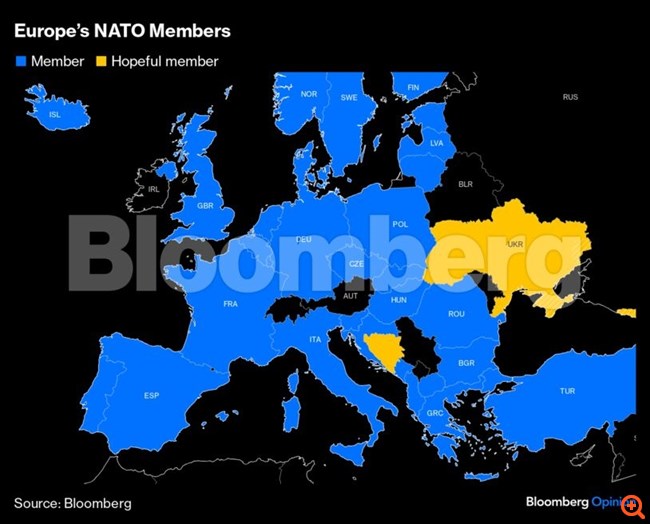Filenews 10 May 2024 - by James Stavridis
With Sweden joining NATO this year and Finland joining NATO last spring, the Baltic Sea has been dubbed "NATO's lake" by some analysts.
A look at a map shows that this is largely (but not completely) true – the coastline has a few chunks of Russian territory. The remaining part of the coastal zone is in NATO hands: Sweden, Finland, Estonia, Latvia, Lithuania, Poland, Germany and Denmark.
Russia controls a chunk of the coast between Lithuania and Poland due to the Kaliningrad enclave. And Russian President Vladimir Putin still controls the eastern corner of the Baltic Sea off St. Petersburg — ironically once seen as the "window to the Western world" by the tsars, starting with Peter the Great. Today, in the event of a conflict between Moscow and NATO, any Russian warship there could quickly and easily be stranded or destroyed.

How should the alliance make better use of its (almost) new lake, and what kind of exercises and training should member states' naval forces conduct to ensure smooth team cooperation?
Exercises in the Baltic
When I was military commander of the alliance, I enjoyed participating every autumn in Baltic operations, or BALTOPS. This top NATO exercise has been conducted since 1972, with the next taking place in a matter of weeks.
I also took part in BALTOPS as an officer several times in the late 1970s, at the height of the Cold War. Back then, the naval situation in the Baltic was quite balanced between US-NATO on the one hand and USSR-Warsaw Pact on the other. Sweden and Finland were strictly neutral. I remember standing on watchtowers on the bridge and having to pay close attention to Soviet warships going in and out of our formations, following us to gather information (often at dangerously close ranges), and generally harassing our ships.
The situation has changed
Things have changed: Last year's Baltic Operation exercise involved 20 nations, with Finland participating for the first time as a full member and Sweden as a candidate member. The exercise involved nearly 50 ships, 45 aircraft and 6,000 naval personnel.
Importantly, the action involved a complex web of air defence exercises, linking NATO's entire land defence grid, along with multiple ships at sea. It was very similar to the coalition the U.S. formed two weeks ago that helped shoot down 250 incoming drones, ballistic missiles and cruise missiles launched by Iran at Israel.
A second element of naval control of the Baltic will be the deployment of air power at sea – planes on our aircraft carriers – to limit Russian air and sea capability. In what was likely a dress rehearsal for operations in the Baltics, a similar level of NATO naval capability has been demonstrated in the Mediterranean over the past two weeks in Operation Neptune Strike: five carrier strike groups and dozens of ships from 11 nations.
Retired Admiral James Fogo, former commander of all U.S. naval forces in Europe (and a key NATO partner a decade ago), was a senior observer and lead the exercise. He told me that it was particularly important to see for the first time a French carrier strike group led by the powerful aircraft carrier Charles de Gaulle under full NATO command.
Russia's reaction
Russia will react to any NATO exercises in the Baltics, although the balance of forces at sea is now largely against it. Next month, they may engage in short-term cyberwarfare. This looks like something they have reportedly been attempting in recent weeks, targeting commercial aircraft. (Finnair was forced to suspend normal daily flights to Estonia after several incidents of interference.) NATO can counter Russia's aggression by exercising both offensive and defensive electronic warfare at Baltops.
Kaliningrad
Finally, NATO will use the Baltic Lake to put pressure on tiny Kaliningrad, which lies between NATO's Baltic states – Estonia, Latvia and Lithuania – and the rest of the alliance. Most of Russia's Baltic Sea Fleet is based there in the port of Baltinisk, and Kaliningrad is home to significant air and missile forces. (There may also be tactical nuclear weapons.) In the event of war, Kaliningrad would have to be neutralized so that Russian ground forces — likely operating through Moscow's vassal state of Belarus — could not take control of the crucial Suwałki gap, which stretches along the border between Lithuania and Poland.
Control and threat avoidance
To some, this threat may seem exaggerated – what are the chances of Putin provoking a major crisis at sea or invading one of the Baltic states? Well, three years ago the idea that he would launch an attack on Ukraine also seemed unlikely — don't underestimate the head in the Kremlin. These small nations certainly take it seriously: The former head of Estonia's military intelligence unit warned that Russia would be ready to attack within four years. Forecasters estimate that Russian troops could capture the capitals of Estonia or Latvia in less than three days.
Fortunately, Sweden and Finland joining the alliance – call it "Putin's nonsense" – gives NATO more options than ever in the Baltic Sea. While Russia has some capabilities, an ongoing program of training, exercise and innovation will ensure that NATO is in complete control of its new lake.
James Stavridis is a Bloomberg Opinion columnist, retired U.S. Navy admiral, former supreme NATO allied commander, and dean emeritus of the Fletcher School of Law and Diplomacy at Tufts University. He is also vice president of global affairs at the Carlyle Group. He serves on the boards of American Water Works, Fortinet, PreVeil, NFP, Ankura Consulting Group, Titan Holdings, Michael Baker and Neuberger Berman and has advised Shield Capital, a cybersecurity investor.
